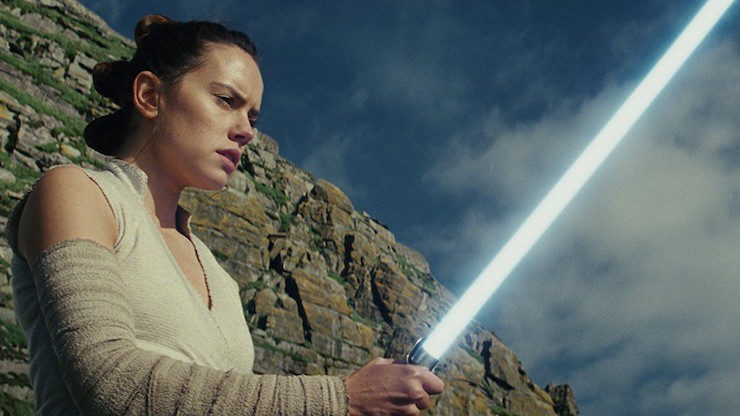The original 1977 Star Wars film is often credited with creating the modern blockbuster: a popcorn-fueled thrill ride that is a feast for all the senses. Before it became known as Episode IV: A New Hope, Star Wars set the template for popular film, from the tight three-act structure to the bombastic film score to the broad strokes of heroes and villains against a visually spectacular backdrop. The commercially driven films that it spawned became densely packed with groundbreaking effects and audience-thrilling action.
This is precisely what makes The Last Jedi, the most recent film and source of the most recent controversy in the franchise, such a wild departure. It’s true that the movie is, like the preceding entries in its canon, very much a Star Wars film: there are space battles and aliens and shootouts, along with lightsaber battles and a John Williams score. But in many ways, it deviates from the original template more than any other Star Wars movie to date, even when compared to the boldly different The Phantom Menace.
All of the films in the Star Wars canon exist with the structure of the commercial blockbuster as its unalterable backbone. From there, they dip into elements of many sub-genres. The original trilogy brought together a melting pot of science fiction, fantasy, and westerns. The ensuing films then pushed the envelope of tone and genre. Attack of the Clones, for example, has an entire B-story that is essentially a noir detective tale, while Rogue One is a combination of war story and heist film. Even Revenge of the Sith can be classified as a Greek tragedy in space opera clothes.
The Last Jedi dips into a new sub-genre as well, one with more direct parallels to the publishing world rather than cinema: literary fiction. But unlike previous episodes—whose sub-genres seamlessly wove into a commercial model—The Last Jedi’s literary fiction elements clash with the standard popcorn mindset. That dissonance is striking, new for the franchise, and goes against so many in-universe expectations that it has caused many fans to leave the theater unsure of what to think as the final credits roll.
Yet many of these same elements seem to work better for fans upon second viewing. In the long run, they may even lead to The Last Jedi being recognized in the upper echelon of the series’ films. But for those that can’t shake the sense that something about the film feels off, even jarring—even if they quite put their finger on what it is—let’s take a closer look.
[Note: This essay contains spoilers for Star Wars: Episode VIII — The Last Jedi.]
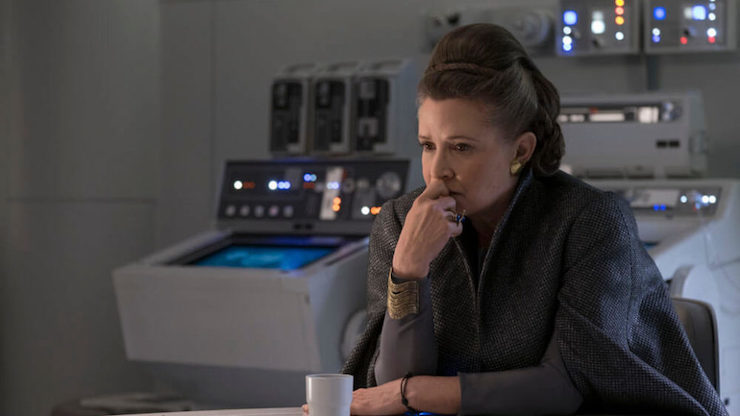
What is Literary Fiction?
Literary fiction as a genre can be hard to define, so much so that it often seems to be identified using the same subjective standards as obscenity—that is, “I know it when I see it.” From an industry perspective, publishing people often classify literary fiction by considering the following qualities:
- The plot is driven by internal character moments rather than external events.
- The story has some level of meta commentary, either on world events or the human condition.
- The pace is slower than commercial stories, allowing character moments to breathe.
- The style emphasizes aesthetics and complexity. In simpler terms, it’s got “pretty” prose rather than the simpler “this happens here and she said this to him” directness that comes with more popular fiction.
Consider the example used by author and former literary agent Nathan Bransford:
The plot may be buried to such a degree (like Gilead) that if you have to describe the book in a short sentence it seems plotless — an old man writes a letter to his young son and reflects on his life. There doesn’t seem to be a plot there. But there is a plot in Gilead. It is about how the protagonist comes to terms with his life and how he reconciles his desire to leave something behind for his son with his impending mortality. Gilead has all the ups and downs of a genre novel, but the plot points all relate to the inner mind, and the climaxes and nadirs are almost hidden in quiet moments and small-but-powerful revelations.
Keep in mind that while some overlap exists in intent between literary fiction and art-house cinema, art films may be plot-driven despite their unique structure or aesthetics (e.g. Memento and Pan’s Labyrinth) or veer into championing dream logic and mystery over traditional storytelling (e.g. David Lynch’s catalog). While The Last Jedi is probably the most artistically unique of the Star Wars franchise, the sub-genre elements align more closely to the conventions of literary fiction than the broad range of art-house cinema.
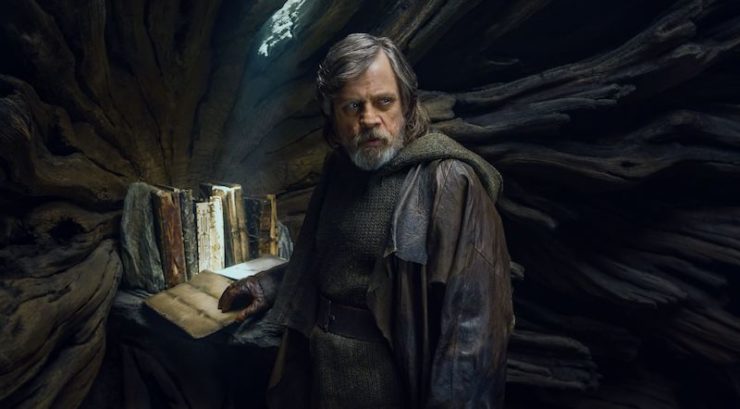
A Literary Jedi
The Star Wars films have landed with a varying level of quality in terms of execution (that’s the nice way of saying fans argue about which ones are good and not-so-good), but they all follow a standard Joseph Campbell hero’s journey/three-act structure. This structure sees the protagonist living his or her life in a known world before being drawn into a new journey, then facing a rising/falling conflict with mentors and allies, until finally all of the primary and secondary events are synthesized into a final resolution—which can be positive or negative.
For example, A New Hope sees Luke Skywalker living his life on Tatooine before being called into action via R2D2’s message. From there, he has an adventure with Obi-Wan Kenobi, Leia Organa, and Han Solo while learning about the Force and gaining a greater understanding of the legacy of the Jedi. In the final act, he brings that all together to destroy the Death Star and fulfill his destiny as a Jedi-in-training. On the other hand, Revenge of the Sith opens with Anakin Skywalker doing his duty as a Jedi Knight on a rescue mission for the Chancellor. He is called into a new journey by visions of his wife dying in childbirth. This leads to rising and falling conflict as his relationships with his mentors and allies change, his allegiance shifting from the Jedi (Obi-Wan, Yoda, Mace Windu) to Palpatine and the Dark Side. This synthesizes into a third act in which Anakin believes that by fulfilling Palpatine’s commands, he can become powerful enough to save his wife—and the galaxy—though in reality the final resolution leaves him physically and emotionally decimated.
Despite taking place in different eras, with their narratives invested with different stakes, tones, and sub-genre elements, they still follow the popular model so familiar to consumers of commercial storytelling: the protagonist experiences internal change through external events, then uses that internal change to bring a larger external conflict to resolution—even when it’s not a happy resolution.
…And then there’s The Last Jedi. One of the common complaints about the film is that from a big-picture perspective, nothing happens. There’s no mega-weapon that’s destroyed, there’s no Jedi-turned-Sith, there’s no Emperor overthrown (okay, there is, but it’s a somewhat inconsequential twist). What does happen? Well, the needle doesn’t move much from a “state of the galaxy” perspective—and that’s kind of the point.
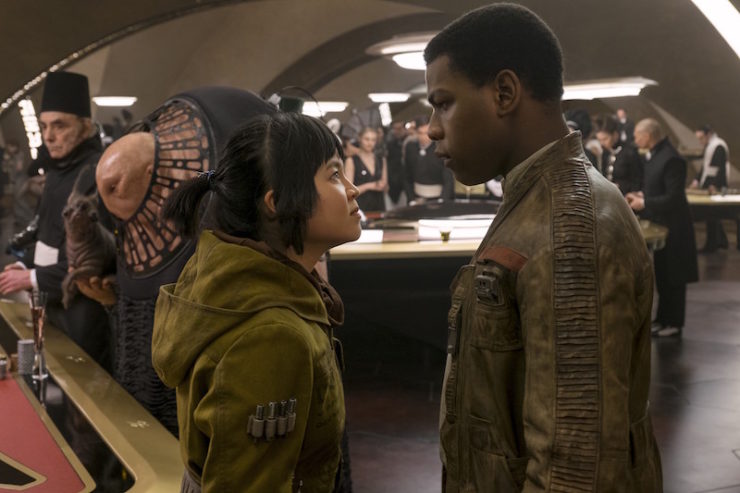
Let’s take a closer look at those literary-fiction elements:
The plot is driven by internal character moments rather than external events: This is the biggest element—at the beginning of the film, the First Order is chasing down the Resistance who are without Luke Skywalker. At the end of the film, the First Order is chasing down the Resistance who are without Luke Skywalker. Yet, the importance of the film from a saga perspective is the internal growth shown by the sequel trilogy’s leads. While it may feel like nothing major is accomplished, the emotional turning points and lessons learned create an anchor for a new generation.
The story has some level of meta commentary, either on world events or the human condition: Much can be said about how The Last Jedi is a commentary on toxic masculinity—the people who don’t learn from it (the First Order) and the people that do (Poe, Finn). It also is built around a message about the value of learning from failure rather than either dismissing it or wallowing in it, as well as the importance of diverse community compared to singular isolation. All of these ideas are part of the ongoing cultural discussion that has been taking place since The Force Awakens hit theaters in late 2015.
The pace is slower than commercial stories, allowing character moments to breathe: The Last Jedi is not exactly a slow film—it is still, at its core, a Star Wars film. But packed between the massive set pieces are numerous character moments which allow us to really understand where these individuals stand at the point in time, such as Luke’s survival living on Ahch-to and Rey’s extended cave sequence (which is significantly longer than Luke’s Dagobah cave visit).
The style emphasizes aesthetics and complexity: The original Star Wars set the visual template for the entire saga—a combination of kinetic action, sweeping vistas based in George Lucas’ love of Akira Kurosawa, and static documentary realism as seen in Lucas’ own American Graffiti. Even with other directors at the helm or in the effects-laden worlds of the prequel trilogy, these core tenets apply. The Last Jedi represents the biggest stylistic break from this style to date, however, employing greater use of unique camera work, interplay of light and shadow, and use of editing tricks such as slow motion and dropping sound.
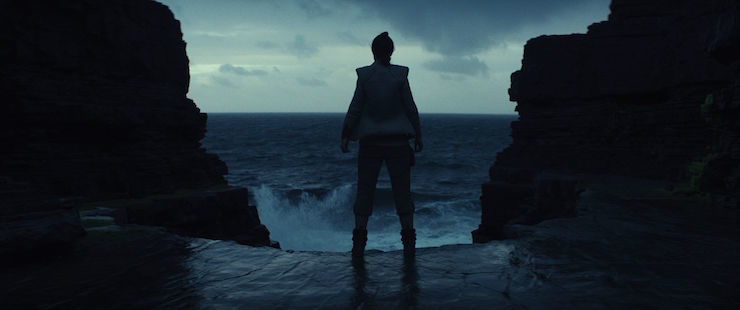
Internal vs. External Victories
Consider all these facets of the film together and it’s clear that while this story takes place in the same universe and features the same characters, it creates a different overall experience than that which Star Wars fans have come to expect. The series has always focused more on victories and defeats, not as much on lessons learned for their own sake—even when Luke trains on Dagobah during The Empire Strikes Back, the story follows a traditional structure where the lessons imparted in the second act lead to a climactic confrontation in the third act. Compare that to the lessons learned by Finn and Poe in this story, in which only Poe’s learning curve provides a tangible step towards the film’s resolution (they escape).
For fans who’ve been put off by the “nothing really happens” nature of The Last Jedi, reframing those expectations can help snap the film into its proper context, and the character-driven elements of literary fiction provide a solid map to do just that. Because saying “nothing really happens” is only true from a certain point of view, and it comes down to this: what ultimately matters more, the momentary victory in the tangible world or a victory for the heart and soul? In many cases, the former cannot happen without the latter.
Rey learned that she only needs herself to be a hero, not an impressive lineage. Poe learned that to be a hero, you must learn to trust the wisdom of others. Finn learned that being a hero means knowing when to live to fight another day. In real life, these internal victories are often much more life-changing (and narrative changing) than the skirmishes we battle on a day-to-day basis. And while this is rare for the Star Wars film experience (though it’s important to note that there are numerous episodes of The Clone Wars and Rebels that focus solely on character lessons), it doesn’t make it any less important.
In fact, when the chronology of this sequel trilogy and its various spinoff stories are complete, we may point to the final act of The Last Jedi as the most important segment for our new generation of heroes—not because they won or lost a fight, but because they embraced who they finally needed to be. In the Star Wars universe as seen in the current trilogy, having our heroes come to those conclusions under the most dire of circumstances allows them to break free from the burden of the past.
This isn’t just important for our lead trio, but for us as fans: by breaking the mold of the past and daring to go in new and different directions that challenge our expectations, Rian Johnson’s The Last Jedi enables Star Wars to evolve in ways The Force Awakens simply didn’t. To accept that, Yoda’s advice to Luke on Dagobah rings true: “Only different in your mind. You must unlearn what you have learned.”
Mike Chen has covered geek and pop culture for a number of popular outlets, including The Mary Sue and The Portalist. A former national sportswriter, his debut time-travel novel Here and Now and Then releases in early 2019 from MIRA Books. Visit his website or follow him on Twitter for geekery discussion, Doctor Who gifs, and many curse words.










